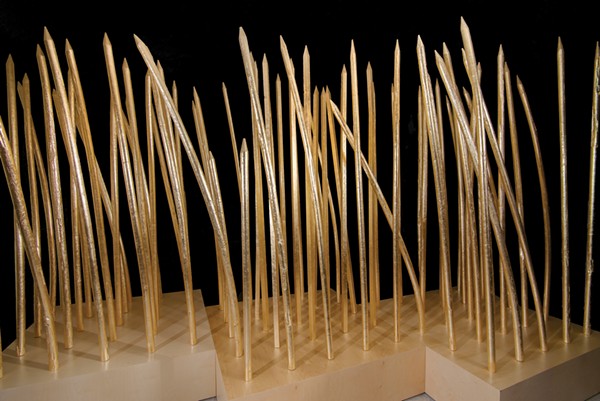All That Glitters
In provocative Stillness exhibition at Bernal Gallery, four artists explore nature and identity
Walk into the newly remodeled Louis Carlos Bernal Gallery at Pima College and the first thing you see is a fairytale forest of golden trees.
In this dazzling installation by Sean-Paul Pluguez, no fewer than 100 “trees” are lined up neatly, row on row, planted into low birch platforms. Bending slightly, as real trees do, they curve upward toward an imagined sky, reaching about six feet into the air.
The trees are actually grape stakes, rough wooden posts that normally would be used to hold up grape vines in a vineyard. But they’ve been transformed by glimmering 24-carat gold leaf, painstakingly applied by the artist over the course of a year. The gold catches the light, and it’s thick and textured, dipping into hollows in the stakes or pushing outwards into lines and patterns.
“The Genetically Modified Forest” is a thing of beauty—who can resist the allure of gold?—but it carries a warning. The stakes are sharp and pointed at the top. And as many fairytale heroines have found, all that glitters is not really gold.
As Pluguez notes in an artist statement, the piece “speaks of man’s limited abilities to deal with his own planet.” We may think we can clear-cut our real forests with impunity or that we can dump coal dust into our streams, a practice lately authorized by our new leaders in Washington.
We can’t disobey the laws of nature for long. When we pollute our rivers, we lose our drinking water, and when we ax our trees, we lose their life-giving abilities to filter out carbon dioxide from the air and provide us with oxygen. A pretty fake forest is no substitute for a real one.
Even so, Pluguez’s meditative installation is a paean to the beauty and stillness of the natural world, properly preserved. It’s the anchor for a group show about nature aptly called Stillness; all four of its artists create a sense of calm in works that cover landscape, animals and the human body.
While Pluguez uses brilliant color, the other three—all photographers—stick with muted tones or even black and white.

